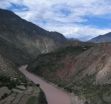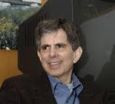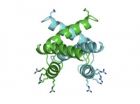(Press-News.org) Earth scientists in Syracuse University's College of Arts and Sciences have determined that the Tibetan Plateau—the world's largest, highest, and flattest plateau—had a larger initial extent than previously documented.
Their discovery is the subject of an article in the journal Earth and Planetary Science Letters (Elsevier, 2014).
Gregory Hoke, assistant professor of Earth sciences, and Gregory Wissink, a Ph.D. student in his lab, have co-authored the article with Jing Liu-Zeng, director of the Division of Neotectonics and Geomorphology at the Institute for Geology, part of the China Earthquake Administration; Michael Hren, assistant professor of chemistry at the University of Connecticut; and Carmala Garzione, professor and chair of Earth and environmental sciences at the University of Rochester.
"We've determined the elevation history of the southeast margin of the Tibetan Plateau," says Hoke, who specializes in the interplay between the Earth's tectonic and surface processes. "By the Eocene epoch (approximately 40 million years ago), the southern part of the plateau extended some 600 miles more to the east than previously documented. This discovery upends a popular model for plateau formation."
Known as the "Roof of the World," the Tibetan Plateau covers more than 970,000 square miles in Asia and India and reaches heights of over 15,000 feet. The plateau also contains a host of natural resources, including large mineral deposits and tens of thousands of glaciers, and is the headwaters of many major drainage basins.
Hoke says he was attracted to the topography of the plateau's southeast margin because it presented an opportunity to use information from minerals formed at the Earth's surface to infer what happened below them in the crust.
"The tectonic and topographic evolution of the southeast margin has been the subject of considerable controversy," he says. "Our study provides the first quantitative estimate of the past elevation of the eastern portions of the plateau."
Historically, geologists have thought that lower crustal flow— a process by which hot, ductile rock material flows from high- to low-pressure zones—helped elevate parts of the plateau about 20 million years ago. (This uplift model has also been used to explain watershed reorganization among some of the world's largest rivers, including the Yangtze in China.)
But years of studying rock and water samples from the plateau have led Hoke to rethink the area's history. For starters, his data indicates that the plateau has been at or near its present elevation since the Eocene epoch. Moreover, surface uplift in the southernmost part of the plateau—in and around southern China and northern Vietnam—has been historically small.
"Surface uplift, caused by lower crustal flow, doesn't explain the evolution of regional river networks," says Hoke, referring to the process by which a river drainage system is diverted, or captured, from its own bed into that of a neighboring bed. "Our study suggests that river capture and drainage reorganization must have been the result of a slip on the major faults bounding the southeast plateau margin."
Hoke's discovery not only makes the plateau larger than previously thought, but also suggests that some of the topography is millions of years younger.
"Our data provides the first direct documentation of the magnitude and geographic extent of elevation change on the southeast margin of the Tibetan Plateau, tens of millions years ago," Hoke adds. "Constraining the age, spatial extent, and magnitude of ancient topography has a profound effect on how we understand the construction of mountain ranges and high plateaus, such as those in Tibet and the Altiplano region in Bolivia."
INFORMATION:
Housed in The College of Arts and Sciences, the Department of Earth Sciences specializes in the teaching and study of tectonics/thermochronology and paleoclimate/environmental science. The department offers a variety of graduate and undergraduate programs, leading to careers in industry, government, private consulting, and academia.
SU geologists prove early Tibetan Plateau was larger than previously thought
Professor Gregory Hoke says parts of ancient plateau were 600 miles longer
2014-04-10
ELSE PRESS RELEASES FROM THIS DATE:
SU professors test boundaries of 'new physics' with discovery of 4-quark hadron
2014-04-10
Physicists in Syracuse University's College of Arts and Sciences have helped confirm the existence of exotic hadrons—a type of matter that cannot be classified within the traditional quark model.
Their finding is the subject of a forthcoming article, prepared by the Large Hadron Collider beauty (LHCb) Collaboration at CERN in Geneva, Switzerland. (LHCb is a multinational experiment, designed to identify new forces and particles in the universe.) Tomasz Skwarnicki, professor of physics, is one of the paper's lead authors.
"We've confirmed the unambiguous observation ...
ACP offers policy recommendations for reducing gun-related injuries, deaths in US
2014-04-10
April 10, 2014 -- A new policy paper from the American College of Physicians (ACP) offers nine strategies to address the societal, health care, and regulatory barriers to reducing firearms-related violence, injuries, and deaths in the United States. Reducing Firearm-Related Injuries and Deaths in the United States is published today in the peer-reviewed medical journal, Annals of Internal Medicine.
Principal among ACP's nine strategic imperatives is the recommendation to approach firearm safety as a public health issue so that policy decisions are based on scientific ...
Single mothers don't delay marriage just to boost tax credit, study says
2014-04-10
MADISON, Wis. – When the Earned Income Tax Credit was expanded in 1993, supporters hoped it would reward poor parents for working while critics feared that it might discourage single mothers from marrying or incentivize women to have more children to boost their tax refund.
A new collaborative study done by the University of Wisconsin-Madison and Cornell University reveals the EITC has helped the working poor but hasn't affected personal choices.
Sarah Halpern-Meekin, assistant professor of human development and family studies and affiliate of the Institute for Research ...
Antennae help flies 'cruise' in gusty winds
2014-04-10
Due to its well-studied genome and small size, the humble fruit fly has been used as a model to study hundreds of human health issues ranging from Alzheimer's to obesity. However, Michael Dickinson, Esther M. and Abe M. Zarem Professor of Bioengineering at Caltech, is more interested in the flies themselves—and how such tiny insects are capable of something we humans can only dream of: autonomous flight. In a report on a recent study that combined bursts of air, digital video cameras, and a variety of software and sensors, Dickinson and his team explain a mechanism for ...
Enzyme revealed as promising target to treat asthma and cancer
2014-04-10
In experiments with mice, Johns Hopkins Kimmel Cancer Center scientists have identified an enzyme involved in the regulation of immune system T cells that could be a useful target in treating asthma and boosting the effects of certain cancer therapies.
In research described online April 6 in Nature Immunology, the investigators show that mice without the enzyme SKG1 were resistant to dust mite-induced asthma. And mice with melanoma and missing the enzyme, developed far fewer lung tumors—less than half as many—than mice with SKG1.
"If we can develop a drug that blocks ...
Researchers discover possible new target to attack flu virus
2014-04-10
Scientists at The University of Texas at Austin have discovered that a protein produced by the influenza A virus helps it outwit one of our body's natural defense mechanisms. That makes the protein a potentially good target for antiviral drugs directed against the influenza A virus.
Better antiviral drugs could help the millions of people annually infected by flu, which kills up to 500,000 people each year.
When an influenza virus infects a human cell, it uses some of the host's cellular machinery to make copies of itself, or replicate. In this study, the researchers ...
For sick, elderly patients, surgical decision making 'takes a village'
2014-04-10
Surgical decision making for sick, elderly patients should be orchestrated by a multidisciplinary team, including the patient, his or her family, the surgeon, primary care physician, nurses and non-clinicians, such as social workers, advocates Laurent G. Glance, M.D., in a perspective piece published in the New England Journal of Medicine.
For this group of patients, surgery can be very risky. Glance, professor and vice-chair for research in the Department of Anesthesiology at the University of Rochester School of Medicine and Dentistry believes a more patient-centered, ...
Medicare's flawed adjustment methodology poor way to spend billions
2014-04-10
Lebanon, N.H. (April 10, 2014) – The methodology Medicare uses to adjust the billions of dollars it pays health plans and hospitals to account for how sick their patients are is flawed and should be replaced, according to a new study by Dartmouth investigators published in the journal BMJ that weighed the performance of Medicare's methodology against alternatives.
The researchers from the Dartmouth Atlas Project compared Medicare's current risk-adjustment methodology, which is based on the diagnoses recorded in patients' claims records, against adjustment indices based ...
American College of Physicians releases policy paper on medical liability crisis
2014-04-10
Washington, DC, April 10, 2014 -- The American College of Physicians (ACP) today released a policy paper on the medical liability crisis, which continues to have a profound effect on the medical system. "Medical Liability Reform—Innovative Solutions for a New Health Care System" provides an update of the medical liability landscape, state-based activity on medical liability reform, and summarizes traditional and newer reform proposals and their ability to affect system efficiency and encourage patient safety.
"While medical liability premiums have leveled off in the ...
New cell models for tracking body clock gene function will help find novel meds
2014-04-10
PHILADELPHIA — The consequences of modern life -- shift work, cell phone addiction, and travel across time zones -- all disturb internal clocks. These are found in the brain where they regulate sleep and throughout the body where they regulate physiology and metabolism. Disrupting the clocks is called circadian misalignment, which has been linked to metabolic problems, even in healthy volunteers.
Researchers from the Perelman School of Medicine at the University of Pennsylvania and the University of Memphis describe in PLOS Genetics the development of new cell models ...
LAST 30 PRESS RELEASES:
School meals could unlock major gains for human and planetary health
Menopause hormone therapy does not appear to impact dementia risk
Signature patterns of brain activity may help predict recovery from traumatic brain injury
Dresden study uncovers new key mechanism in cancer cells
New species are now being discovered faster than ever before, study suggests
Cannabis-based products show limited short-term benefit for chronic pain, with increased risk of adverse effects
Cannabis products with more THC slightly reduce pain but cause more side effects
Clearing the brain of aging cells could aid epilepsy and reduce seizures
Brain injuries linked with potential risk of suicide, new study finds
New technique lights up where drugs go in the body, cell by cell
New study finds movement of fishing fleets can reveal shifts in marine ecosystems
Embargoed: New evidence points to potential treatment for vascular dementia
Study uncovers disrupted brain balance in alcohol dependence
Working in groups can help Republicans and Democrats agree on controversial content moderation online
Structural findings reveal how distinct GPCR ligands create different levels of activation
Anything-goes “anyons” may be at the root of surprising quantum experiments
UC review: Maximizing workplace opportunity for veterans
From generation to complex control: Metasurfaces make perfect vortex beams "within reach"
Thin-film lithium niobate-based detector: recent advances and perspectives
Exploring why some people may tend to persistently make bad choices
How cells balance their protein levels
Nirsevimab vs RSVpreF vaccine for RSV–related hospitalization in newborns
Effectiveness and impact of maternal RSV immunization and nirsevimab on medically attended RSV in US children
AI gives scientists a boost, but at the cost of too many mediocre papers
Next-generation vision model maps tree growth at sub-meter precision
Genes aren’t destiny for inherited blindness, study shows
MIT study: High-fat diets make liver cells more likely to become cancerous
Exposure to multiple fine particulate matter components and incident depression in the US Medicare population
Risk of burdensome health care spending over time in the US
Nirsevimab against hospitalizations and emergency department visits for lower respiratory tract infection in infants
[Press-News.org] SU geologists prove early Tibetan Plateau was larger than previously thoughtProfessor Gregory Hoke says parts of ancient plateau were 600 miles longer


